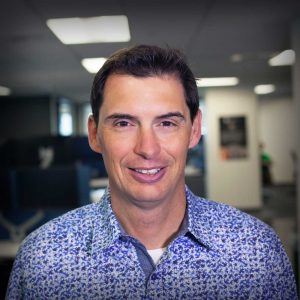Learning from Leaders at the Tech @ the Top Speaker Series: Gene Farrell
The Tech @ the Top speaker series showcases successful leaders, executives, and entrepreneurs from a variety of organizations. Topics span leadership, entrepreneurship, globalization, social innovation and business growth strategies. An event brings students, alumni, and community members together to network and learn from the leadership philosophies and strategies that have transformed a speaker’s career, organization, and life.
I organized the Tech @ the Top series. The series is an important part of the MBA experience as it enhances the learning, reflection, and application of students’ studies. Here is my recap and impressions of our third speaker in the fall 2017 series, Gene Farrell.
~ Susie Buysse, Senior Associate Director for the work-compatible Technology Management MBA and Hybrid MBA Programs

Gene-Farrell, Senior VP, Smartsheet
The fall 2017 Tech @ the Top series finished with a dynamite talk by Gene Farrell, Senior Vice President of Product at Smartsheet, a fast-growing enterprise startup with a powerful SaaS platform for organizations to plan, track, automate, and report on work. Gene completed his 18-month Executive MBA degree from Emory University’s Goizueta Business School during his 24-year career at the Coca-Cola Company. He served in leadership roles in sales, marketing, and general management. In his last 7 years, Gene was recruited to “help Coke get their mojo back” by founding an internal startup that developed the Coca-Cola Freestyle Business Unit.
After launching Coca-Cola Freestyle, Gene decided to return to Seattle with his family where he joined Amazon Web Services. At Amazon he built and led the enterprise apps groups for AWS, rapidly developing a suite of clouds services such as Amazon Workspaces, Amazon WorkMail, and Amazon Chime.
Gene’s talk focused on innovation and how some of the fastest growing companies in the world apply a process called “working backwards from the customer”. He quickly engaged the audience by asking, “Why is it so hard to innovate? What gets in the way?” Students volleyed answers such as politics, risk, internal processes, bureaucracy, unclear sponsorship, and an inability to understand the marketplace.
Gene described factors behind the significant success of the Freestyle soda fountain. He said, “Innovating at a 125-year old company is pretty challenging. We had senior executive sponsorship and the CEO was involved from day one. We had a small dedicated team that was isolated from the rest of the organization and reported to an internal board of directors, and we received capital and ran our own schedules. We started with and worked backwards from the customer with fast decision making, and also used a process called stage gate to manage the investment. It’s a process of working to a milestone and decision before enhancing the investment.”
Gene also shared perspectives on how Amazon is achieving hyper-growth and how they scale and remain nimble with disruptive innovation:
- It starts with who they hire and Amazon hires builders. Builders are people who want to create and try to build a business for a service. Builders are comfortable with ambiguity, risk, and failure.
- Amazon runs their business like a series of startups and they use AWS. They’re all autonomous and many times they can be working on similar things. It’s basically “Let’s go and let’s go fast.”
- Before you build anything, you write a press release as if you’re launching that product with a set of frequently asked questions. It’s called a PR/FAQ. You then get together with key decision-makers and read it, argue about it, and decide what to build — with a focus on building a minimum viable product. What is the lightest feature set I can offer to get to market quickly and get feedback from customers to learn what I need to build to actually satisfy all customer demand? Amazon has a leadership principal called disagree and commit, where you state your case, fight hard for your position, make a decision, and then (whether you agree with it or not) go forward and execute.
- The most important one is a willingness to fail. The thing that Amazon does really, really well is they separate an individual from the work. They definitely take a hard look at what went wrong and what was learned but know that most of the things they try aren’t going to work and this lowers the personal risk factor for their employees. Try more things, learn faster, and figure out how to move forward.
- Amazon is exceptional at how they think about business opportunities. They play the long game. They’re willing to be very patient with ideas and let them develop over time, and you see this in their business today. Alexa is a great example.
Gene’s visit clearly resonated with our group. Jason McKay, a senior naval officer and Foster Hybrid MBA student said, “What was neat is how Gene Farrell’s talk tied so directly into Professor Bruce Avolio’s leadership course. Last night during Foster Live, Bruce talked about what he calls surface and deep innovation. Gene called it ‘incremental’ and ‘disruptive.’ One of our discussions in small groups was how a company supports innovation or doesn’t support it. Of course, Gene Farrell’s elements of Amazon’s secret sauce speak to encouraging innovation. I can’t wait to go to more Tech @ the Top events in the future and I’m encouraging my fellow Hybrid MBA classmates to do the same!”
